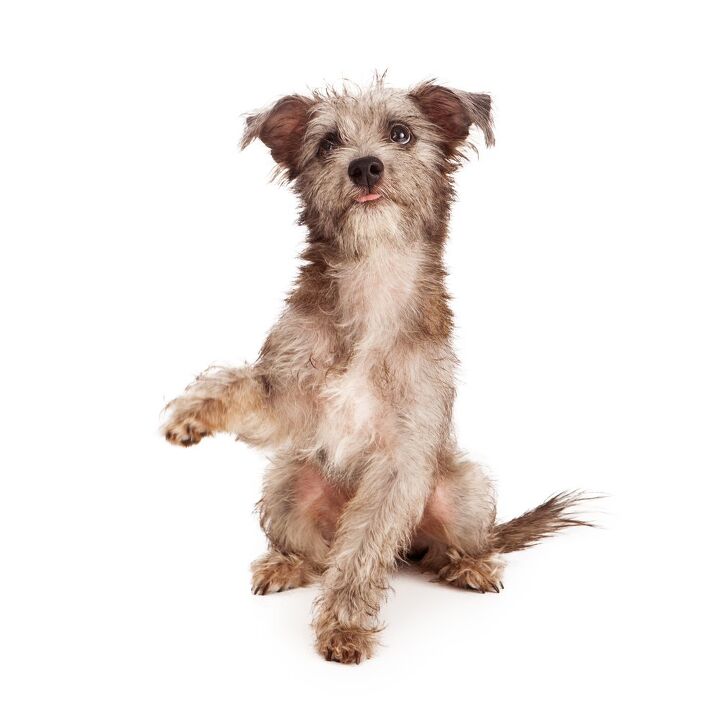Ratese


About Ratese
Small, spunky, and sweet, the adorable Ratese will charm your pants off. This recent designer dog breed was developed by crossing the Maltese with a Rat Terrier. Their mixed breed baby is a small dog with medium to long hair and a personality that leaves no one indifferent. The Ratese might be petite, but he sure does think he’s a big, scary pooch! These dogs often have a spirit that goes past their tiny frame, and they make great pets for people who want a lively, playful pooch with a friendly attitude.
The Ratese is fairly active, but due to its size, this hybrid breed is suitable for apartment living and seniors who are up for a few daily walks. This Maltese and Rat Terrier mix is adaptable, so they’ll fit in with families of all shapes and sizes. However, owing to its nippy parents, the Ratese is not a good fit for households with young children, as they won’t hesitate to react if (unknowingly) bothered by a toddler.
This Maltese and Rat Terrier mix is adaptable, so they’ll fit in with families of all shapes and sizes.
Until recently, what we now call designer breeds were categorized as mutts or simply mixed breed dogs. Any crossbreeding between purebred dogs was purely accidental ( like the Queen Elizabeth’s Dorgis) and intentionally mixing was unheard of. In the last two decades, however, more and more breeders are getting enthusiastic about hybrid dogs, as there is an ever-growing desire to create new breeds with enhanced or improved traits. Naturally, it’s hard to determine when the intentional breeding of designer dogs started and if every dog with mixed lineage is considered a designer breed. For the overwhelming majority of hybrid dogs, their origin is usually somewhere in the United States and the date they were first created is placed in the last 10 to 20 years.
For the Ratese, nothing is different. Your new hybrid puppy might come from a breeder or a shelter, but it won’t change a bit about their true origin- a Maltese and Rat Terrier mom and dad.
When talking about pedigree for designer dogs, most people think about official papers or certifications. However, as none of the hybrid breeds is officially recognized by the American Kennel Club or its counterparts, there is no possible way for these unique canines to obtain pedigree papers. But, even though your Ratese puppy might not have papers that document its lineage, it doesn’t mean that their ancestry is mysterious. Every Ratese is the offspring of Maltese and Rat Terrier parents. Both of the parental breeds are recognized by the American Kennel Club and can have pedigree papers. In case you are getting a Ratese puppy from a breeder, they’ll be able to give you more insight into your pet’s family tree.
Even without a pedigree, the parentage of the Ratese tells us more than enough about this breed. The Maltese and Rat Terrier are small dogs with impressive intelligence and lively personality. Both are suited to companionship roles and do well as family pets- it’s only natural that the same goes for their offspring.
The dietary needs of a Ratese dog are not much different than those of any other small breed pooch. Their nutritive needs can be met with a high-quality dry food for dogs that is made especially for canines of their size. Furthermore, you should pick out a kibble blend that suits their age (puppy, adult, senior) and their activity level (moderate to active).
In case your Ratese puppy favors the Maltese parent more, he or she might have a sensitive digestive system. Not unlike most white coat breeds, the Maltese is prone to food allergies, and this trait is sometimes passed along to its puppies. In case this is true, opt for grain-free foods or kibble based on alternative protein sources, such as lamb, venison, or buffalo.
Even though you might need to have slightly more patience with a Ratese puppy, it’s crucial to train and socialize them on time.
Owing to its parents, the Ratese is a highly intelligent pooch that loves to please its owner. However, this doesn’t necessarily mean that these designer dogs are easy to train. This particular mix of breeds can often have a strong-willed personality and can be a bit difficult to teach. On the other hand, using a positive reinforcement method of training is certain to coax them into becoming a model student. After all, who wouldn’t get on their best behavior for some treats and praise?
Even though you might need to have slightly more patience with a Ratese puppy, it’s crucial to train and socialize them on time. In particular, teaching this designer dog that it’s not OK to nip at people and not to boss around other animals are a great place to start. The Ratese can be impatient with children and quick to nip if provoked, so it’s essential to work with them if you have young children in the environment.
One of the rare certainties with designer dog breeds is that you can never be certain how these pooches will look like when fully grown. For the Ratese, though, there’s not much mystery surrounding their size in maturity. Both the Maltese and the Rat terrier are petite pooches, and their offspring can’t stray much from that. Depending on your Ratese puppy’s sex and individual traits, they can weigh anywhere between 15 to 25 pounds in their adulthood.
The Ratese is one of those dogs that have a personality that’s much bigger than their petite frame. Friendly, energetic and with a happy-go-lucky attitude, these hybrids are natural charmers. Their playful behavior and intelligence make them great playmates to other four-legged family members, too, as long as they get along with them. The Ratese is curious and needs to be engaged and stimulated with games, puzzle toys, and interaction with his owner. Otherwise, the might get bored, and quickly after that, destructive.
In most cases, these mixed breed dogs are real cuddle bugs. They’re affectionate and fiercely loyal to their owner, and won’t be shy about showing off that devotion. If allowed, the Ratese will become a velcro pooch, always near you and looking for your attention. It’s best to not let them get overly attached though, as this can lead to separation anxiety.
Like so many small breed dogs, these hybrids also seem to be completely unaware of their size. More often than not, this means they’ll get in trouble at the dog park or imagine their duty is to ward off any danger to their territory or family. While it can be cute at times, this “ small dog syndrome” can lead your brave pooch into trouble with other canines so make sure not to let them get too cocky.
One of the terms that are often mentioned when you research designer dog breeds is hybrid vigor. This relates to the belief that hybrids, or mixed breed dogs, are more resilient, healthier and have improved physical traits when compared to their purebred fellows. Of course, there’s no tangible proof for this. There have been some instances where introducing a new breed into the gene pool led to fewer health issues, but it’s in no way a guarantee for good health by default.
For the Ratese, there are not that many breed-specific illnesses to worry about. Owing to its parents, this designer dog can be predisposed to patellar luxation (kneecap dislocation), hip and elbow dysplasia, as well as congenital heart issues such as PDA. Additionally, they can be affected by food allergies and early tooth loss (like all dogs of this size).
When it comes to designer dogs, it’s not easy to accurately guess their lifespan. In all fairness, most of these dogs haven’t been alive long enough for us to do so. However, based on the lifespan of its parental breeds, the Maltese and the Rat Terrier, we can guesstimate the life expectancy of the hybrid offspring. With proper care and good living conditions, a Ratese puppy can grow up to be 14 to 17 years old.
If you thought that a cute, small pooch like the Ratese doesn’t need much exercise, think again! These tiny furballs are full of energy and need to burn it off on a daily basis, lest they become mischievous and turn on your furniture instead. Fortunately, they are not as difficult to tire out as some of their larger cousins, but they do still need a fair amount of activity to stay content and healthy.
As a rule of thumb, a Ratese will need an hour to 90 minutes of daily exercise. This can be divided into a couple of brisk walks around the block, coupled with a visit to the dog park or a game of fetch in the backyard. Additionally, due to their bright minds, they’ll also need to be mentally stimulated- get your pooch some interactive dog toys to keep them entertained and out of trouble.
These tiny furballs are full of energy and need to burn it off on a daily basis.
As we’ve already mentioned, the AKC and its international counterparts do not recognize designer dogs as actual breeds. There are many reasons why these canine organizations can’t give recognition to dogs of mixed lineage, but that doesn’t mean that no clubs recognize the Ratese. There are a number of canine organizations that are focused on hybrid dogs, and those of them that recognize the Ratese are American Canine Hybrid Club, Designer Dogs Kennel Club, and the International Designer Canine Registry.
The Maltese and Rat Terrier are worlds apart when it comes to their hair. The first parent boasts long, non-shedding white coat, where its terrier partner is known for the close-cropped hair in two or three colors. Naturally, their offspring can take up after one or the other more; or end up being a perfect blend of both. Sometimes, there are dramatic differences in appearance of the Ratese puppies even across one litter!
However, in most of the cases, these hybrids have a medium to long hair, soft to touch and moderate to low shedding. In certain instances, the puppy can inherit the Maltese’s hypoallergenic fur, but it’s not a common thing. As for the color of the Ratese coat, there are many possible combinations: from cream, tan, or pied to bi-colored coat in a brown-white or black-white blend.
Ratese puppies are tiny, lovely and absolutely heart-meltingly cute! However, setting boundaries from the start is important. The Ratese can be difficult to housebreak due to its stubbornness, so it’s recommended you teach them basic manners early on. Similarly, these designer dogs have a tendency to get along poorly with strangers or young children, and it wouldn’t hurt if you make sure that they’re socialized on time.
These lovable hybrids have a fun, playful and affectionate personality that makes them a great pet for families with older children or active singles. They do need a bit more exercise than your average small breed dog, so they might not be the ideal match for owners looking for a low-maintenance pet.
Photo credit: LagunaticPhoto/Shutterstock; Susan Schmitz/Shutterstock

A proud mama to seven dogs and ten cats, Angela spends her days writing for her fellow pet parents and pampering her furballs, all of whom are rescues. When she's not gushing over her adorable cats or playing with her dogs, she can be found curled up with a good fantasy book.
More by Angela Vuckovic
























